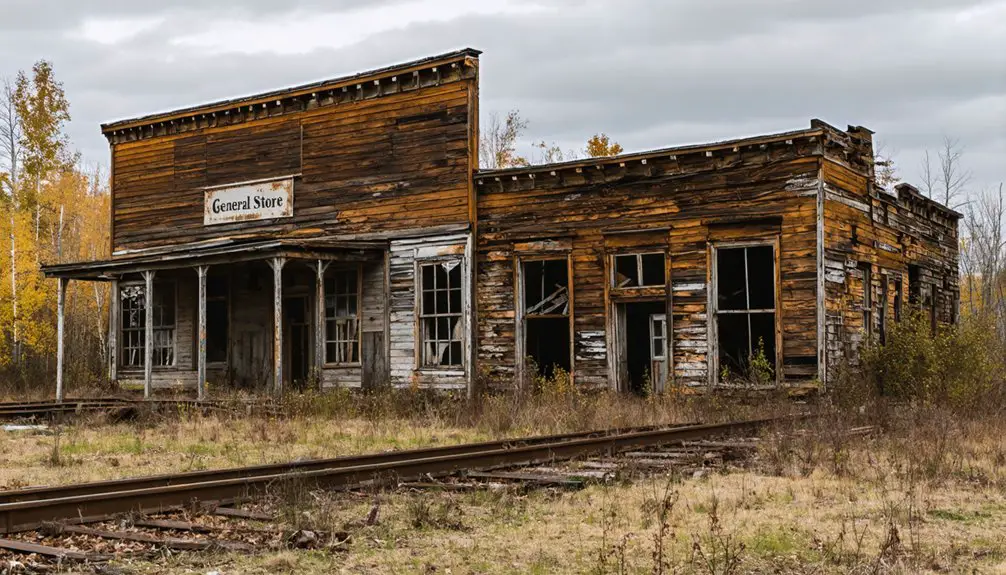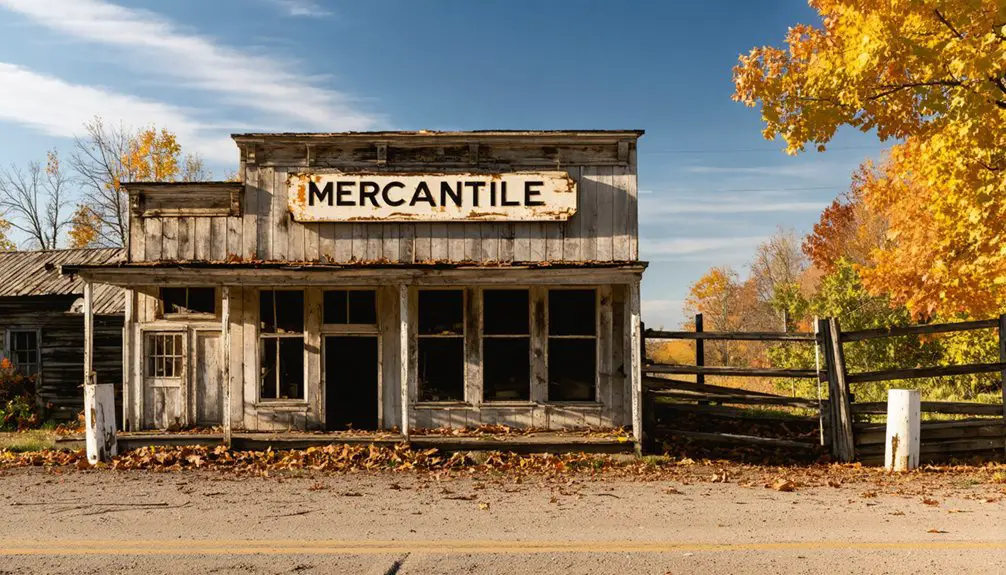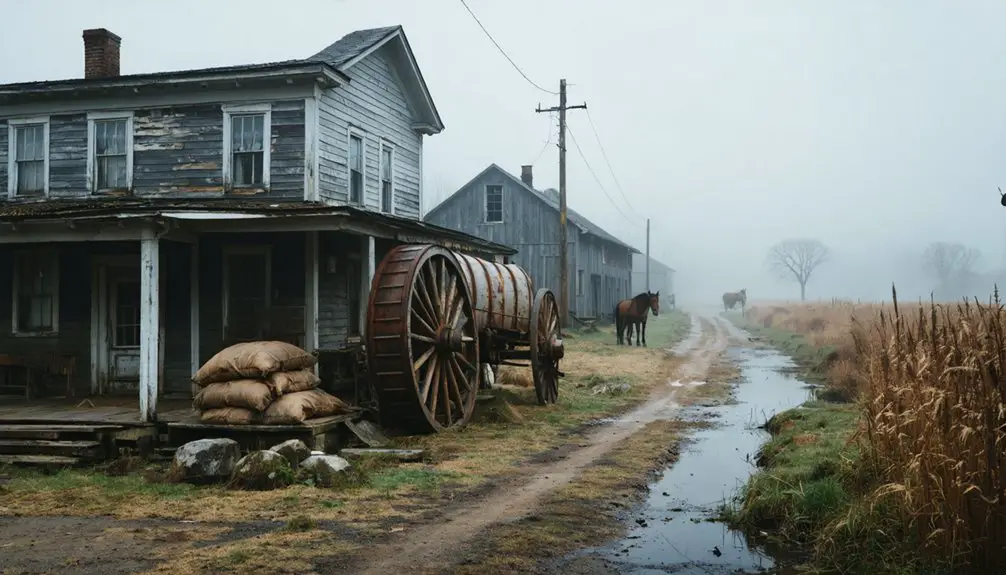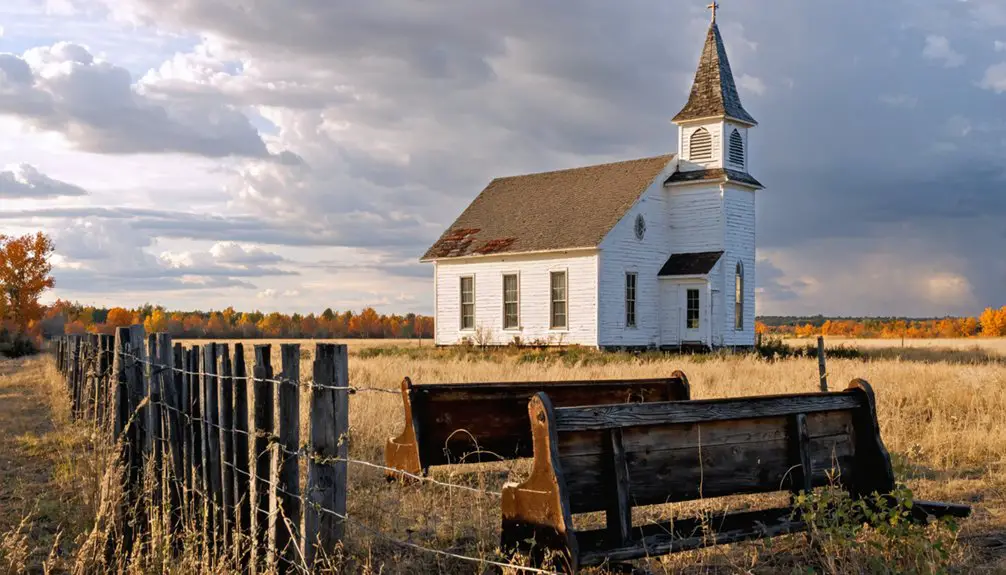You’ll find Sharon’s ghost town traces in Manchester, Michigan, where Amasa Gillett and Benjamin Burnett’s 1834 sawmill launched a booming lumber settlement. The Pere Marquette Railroad transformed the town into a bustling commercial hub by the late 1800s, with a 500-foot dock handling four schooners. The town’s story lives on through Sharon Cemetery’s 260 interments, where mysterious orbs and unexplained lights suggest there’s more to this former mill town’s legacy.
Key Takeaways
- Sharon transformed from a bustling lumber town into a ghost town after the depletion of white pine forests caused mill closures.
- The Schomberg Hardwood Lumber Company, established in 1859, marked Sharon’s peak before its eventual decline and abandonment.
- The Pere Marquette Railroad depot, once a vital commercial hub, fell into disuse as lumber operations ceased.
- Sharon Cemetery, with 260 interments, remains one of the few tangible remnants of the former thriving community.
- Abandoned company stores, mercantiles, and lumber barons’ mansions stand as silent witnesses to Sharon’s former prosperity.
Rise of a Northern Michigan Lumber Town

As the 1836 Treaty of Washington opened Northern Michigan’s lands for private acquisition, the region quickly transformed into a competitive logging frontier.
You’ll find Sharon’s story began amid fierce timber disputes between Muskegon River and Saginaw Bay districts, where ambitious loggers vied for control of the richest forest stands.
In 1837, Henry Pinoyaire established the first commercial mill on the Muskegon River, setting the stage for a timber boom that would shape the region.
Pinoyaire’s pioneering 1837 Muskegon River mill marked the beginning of Michigan’s transformative logging era.
Advanced logging techniques and efficient sawmills soon dotted the landscape, converting massive logs into marketable lumber, much like the successful Ford sawmill operations that would later emerge in Alberta.
The Muskegon River alone transported an impressive 30 billion board feet of timber, while innovative grading systems helped maximize profits.
Sharon emerged as one of many bustling lumber towns, drawing settlers with promises of employment and prosperity in Michigan’s flourishing timber economy. The town’s success relied heavily on skilled workers from Canada and New England who brought their expertise in water management and log handling.
Life Along the Pere Marquette Railroad
The Pere Marquette Railroad transformed Sharon from a remote lumber settlement into a connected hub of commerce and community life in the late 1800s. The railway’s less-than-carload service provided vital next-day deliveries of supplies to local merchants.
You’d find the railroad’s presence woven deeply into Sharon’s railroad heritage, with the station serving as the heart of daily activities. Steam locomotives thundered through town, bringing mail, supplies, and connecting Sharon’s residents to Grand Rapids and Ludington’s bustling markets. When the Van Sweringen brothers took control in the 1920s, they brought modernization efforts that briefly revitalized the line through Sharon.
- Telegraph lines hummed with news and messages along the tracks
- Water towers and fuel stops kept the mighty steam engines running
- Local workers maintained tracks, switches, and signal systems
- Seasonal lumber crews arrived by rail to work nearby forests
- The depot buzzed with activity as freight and passengers came and went
These community connections fostered Sharon’s growth until the post-WWII shift to diesel engines and declining timber production changed everything.
The Bustling Days of Sharon’s Commerce

You’ll find Sharon’s economy was largely driven by the Schomberg Hardwood Lumber Company‘s sawmill operations, which anchored commerce in the area by 1859.
The railroad depot became a vital trading hub where farmers exchanged their agricultural products and lumber was shipped to broader markets through an expanded 500-foot dock that could accommodate four schooners at once. Just like the historic 900 ft dock at Fet Harbor, it served as a crucial shipping point for the region. Similar to South Boardman’s peak years, the town supported three lumber mills that provided significant employment to the region.
The depot’s strategic location along the Pere Marquette Railroad transformed Sharon into a bustling commercial center, where company stores and a two-story mercantile served both the timber industry workers and local farming families.
Sawmills Drive Local Economy
Founded in 1834 by entrepreneurs Amasa Gillett and Benjamin Burnett, Sharon’s first sawmill transformed the sleepy hamlet into a bustling commercial center along the River Raisin.
The sawmill workforce quickly grew as timber trade flourished, with John Rice later adding a gristmill to diversify operations. Native Americans who had practiced agriculture in the region for centuries provided valuable knowledge about local resources.
You’ll find the economic impact rippled through the region until the early 1900s, creating wealth from raw lumber and supporting various allied businesses.
- Workers harvested local timber and processed it into construction materials
- Skilled craftsmen and laborers formed a diverse economic workforce
- The mills generated valuable byproducts for additional commerce
- Sawmill operations attracted settlers and new businesses to Sharon Hollow
- The 5701 Sharon Hollow Road location became the community’s industrial heart
The mills remained essential to Sharon’s economy until Henry Ford’s acquisition in 1926. The facility was restored and reopened as a village industry site in 1939, operating until its closure in 1947.
Railroad Depot Trading Hub
While Sharon’s sawmills drove local industry, its Pere Marquette Railroad depot transformed the settlement into a dynamic trading hub by 1880.
Similar to Williamston’s first depot, Sharon’s station enhanced business activity and social connections for 15 years until disaster struck.
You’d find the depot’s architecture typical of branch line stations, with its crucial water tower and freight handling facilities positioned strategically along the tracks, about 12 miles south of Kalkaska.
Just as National Historic Registry sites preserve railway heritage, the depot connected you to vast trade networks throughout Michigan and the Great Lakes region. You could’ve watched merchants loading agricultural produce and lumber onto railcars, while others bartered for incoming supplies from urban centers.
Local businesses thrived as the depot brought buyers and sellers together, creating a bustling marketplace where you’d encounter travelers exchanging news and goods.
The station’s strategic location made it essential for commerce, connecting Sharon’s enterprises to Michigan’s expanding industrial markets.
Tales From the Historic Cemetery
Nestled in the rural outskirts of Manchester, Michigan, Sharon Cemetery harbors tales that have captivated locals and paranormal enthusiasts since its establishment in 1880.
Deep in Michigan’s countryside, Sharon Cemetery weaves supernatural stories that have enthralled visitors for generations.
You’ll find approximately 260 interments here, including a Revolutionary War soldier’s grave and Civil War veterans, each adding to the site’s historical significance.
The cemetery’s reputation for ghostly encounters stems from numerous reported paranormal activities, while a pervasive witch legend tells of a cursed woman whose presence allegedly led to the town’s decline.
- Mysterious orbs and unexplained lights dance among the headstones
- Children’s laughter echoes through the moss-covered grounds
- Intricate funerary art features lambs and heaven’s gates
- Handprints mysteriously appear on visitors’ vehicles
- A witch’s grave serves as a focal point for supernatural tales
Daily Life in a 19th Century Mill Town

You’d find mill workers living in modest timber-frame houses near the mill, often sharing cramped quarters with other laborers during the busy harvest seasons of the 1850s and 1860s.
After exhausting 12-hour shifts of grinding grain or sawing lumber, workers would gather at the local tavern for singing and socializing, or join community events like barn dances.
Entertainment options remained simple but meaningful, with many workers participating in quilting bees, plowing bees, and church gatherings that helped maintain Sharon’s close-knit social fabric.
Mill Worker Housing Conditions
As industrialization swept through the American landscape in the 19th century, mill workers in Sharon, Michigan faced harsh living conditions in company-owned housing that exemplified the era’s stark inequalities.
You’d find yourself paying between fifty cents to a dollar per room in cramped quarters that the mill owners controlled completely. Worker conditions were defined by oppressive rental agreements that required multiple family members to work in the mills just to maintain housing.
- Shared brick rowhouses packed multiple families into two-story structures
- Up to 15 people might share a single room with communal sleeping arrangements
- Poor ventilation and dampness led to widespread respiratory illness
- Limited sanitation facilities increased disease outbreaks
- Mill owners controlled both housing and company stores, creating total dependency
Entertainment After Long Shifts
Despite grueling work conditions and crowded housing, Sharon’s mill workers carved out moments of joy during their limited leisure time.
You’d find them gathering for evening lantern hikes, sharing stories of immigrant journeys and labor struggles while walking the town’s familiar streets. The natural surroundings offered peaceful respites, with fishing spots along nearby waterways and garden plots that provided both food and recreation.
Outdoor pastimes weren’t their only entertainment. After shifts ended, workers would congregate in barns and community halls for lively dances, while homes lit by oil lamps became havens for quiet activities like sewing and storytelling.
Sports brought everyone together – from impromptu baseball games to croquet matches. These simple pleasures helped forge strong community bonds among Sharon’s hardworking residents.
The Last Days of Lumber Glory
When Michigan’s legendary white pine forests began showing signs of depletion in the late 1880s, Sharon’s once-bustling lumber operations faced an inevitable decline.
You’d have witnessed the transformation as logging techniques evolved in a desperate attempt to extract remaining timber, while economic shifts rippled through the community. The town’s prosperity, built on the mighty white pine, began slipping away as mills closed and workers sought opportunities elsewhere.
- Winter logging became essential as frozen ground allowed access to remaining timber stands
- Rivers that once teemed with log drives fell silent as timber supplies dwindled
- Lumber barons’ mansions stood as final monuments to the industry’s golden age
- Local businesses struggled as the seasonal workforce disappeared
- The surrounding landscape bore the scars of clear-cutting, marking the end of an era
Sharon’s Transformation to Farmland
While Sharon’s lumber industry faded into history, the township’s rich soil and strategic location sparked its rebirth as prime farmland in the late 19th century.
You’ll find a strong commitment to farmland preservation here, exemplified by the Irwin family farm‘s continuous operation since 1836 and its recent protection through a conservation easement with Legacy Land Conservancy in 2021.
The township’s agricultural heritage remains fiercely protected, as demonstrated in 2024 when residents successfully blocked Stoneco’s attempt to convert 400 acres into a gravel mine.
You’ll see how this rural community actively safeguards its farming future through legal mechanisms and collective action.
Despite Sharon’s ghost town status, the surrounding farmlands continue to thrive, maintaining the area’s agricultural character and economic stability through careful stewardship of the land.
Legacy in Stone and Memory
Although Sharon’s original buildings have vanished, its legacy endures most prominently in the Sharon Cemetery, established around 1880 at the intersection of Sharon Hollow and Sharon Valley Roads.
You’ll find over 260 interments that tell the story of this vanished community through cemetery symbolism and artistry unique to the region.
- Distinctive headstones feature doves and unidentified symbols reflecting local cultural traditions
- Graves of Revolutionary War and Civil War veterans connect Sharon to America’s military heritage
- An impressive nearby Lincoln memorial anchors the area’s historical political significance
- Infant and children’s graves reveal the harsh realities of early rural life
- 19th-century epitaphs and carved imagery showcase the community heritage through period-specific funerary customs
These silent stone sentinels preserve Sharon’s memory when buildings could not.
Frequently Asked Questions
Are There Any Remaining Original Structures From Sharon’s Lumber Town Era?
You’ll find the original 1830s lumber mill still standing at Sharon Mills County Park, where historical preservation efforts maintain the structure for events and educational displays.
What Happened to the Families Who Lived in Sharon After It Declined?
You’ll find most families relocated to nearby Michigan towns seeking better economic opportunities. They left behind their farming roots, pursued urban employment, and maintained connections through local cemeteries despite widespread dispersal.
Were There Any Notable Crimes or Incidents During Sharon’s Peak Years?
Like a calm lake’s surface, you won’t find ripples of unsolved mysteries or criminal activities here. Historical records show no significant incidents during Sharon’s peak years in rural Michigan.
Did Native American Communities Interact With the Sharon Lumber Settlement?
You’ll find limited records of direct interactions, though Native Americans likely crossed paths with settlers along traditional trade routes, enabling cultural exchange through Michigan’s extensive logging territories during the 1870s-1880s.
What Natural Disasters or Fires Affected Sharon During Its Active Period?
You won’t find documented flooding events or timber fires affecting Sharon, as historical records show no major disasters during its active period – only gradual decline through agricultural and economic changes.
References
- https://travelswithabandon.com/2019/05/08/adventure-11-federman-and-sharon/
- https://99wfmk.com/sharon-ghost-town/
- https://99wfmk.com/south-boardman-1900-2020s/
- https://travelswithabandon.com
- https://en.wikipedia.org/wiki/List_of_ghost_towns_in_Michigan
- https://www.youtube.com/watch?v=se0KF6YpcXI
- https://www.youtube.com/watch?v=KgrlU6D4l-s
- https://www.hmdb.org/m.asp?m=229550
- https://www.connorcoyne.com/blog/2010/03/hungry-rats-a-story-about-evil-lumberjacks/
- https://en.wikipedia.org/wiki/Pere_Marquette_Railway



